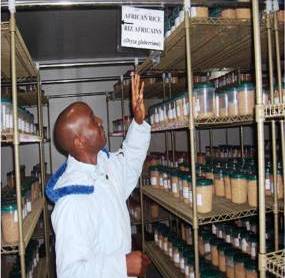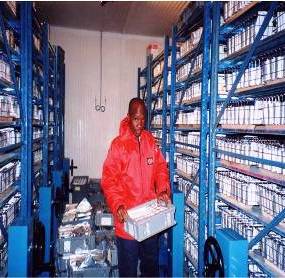Conservation of rice genetic resources
Contributors to this page: T.T. Chang Genetic Resources Centre-IRRI, Los Baños, Philippines (Ruaraidh Sackville Hamilton, Ken McNally, Flora de Guzman, Renato Reaño, Soccie Almazan, Adelaida Alcantara, Elizabeth Naredo); WARDA, Cotonou, Benin (Ines Sánchez); UPLB-University of the Philippines at Los Baños (Teresita Borromeo).
 Diversity of rice seeds (photo: IRRI) |
Importance of rice conservation
Ex situ conservation is a safe and efficient way to conserve rice genetic resources and to make the germplasm readily available to breeders and other researchers.
Traditional rice varieties and the wild rice species are being lost through genetic erosion. The farmers often adopt modern, new rice varieties (that produce more grain in less time) and no longer grow the traditional varieties they have been using for generations. When farmers switch from cultivating rice to growing other crops, the old rice seeds are also often forgotten. Eventually many of these traditional rice varieties are lost. Wild rice species are particularly threatened with extinction as their habitats are destroyed by human disturbance and by the rapidly changing and growing world. Future crop improvement needs the genetic variation of these traditional varieties and related wild genera to cope with the many biotic and abiotic stresses that are challenging rice production for both current and future generations.
Major rice collections
More than 219 000 accessions of cultivated and wild rice are stored in genebanks in more than 40 countries. Many of these accessions are duplicates, therefore this number does not necessary reflect the genetic diversity of this crop.
Currently the major rice collections in the CGIAR are maintained by the International Rice Research Institute (IRRI) and Africa Rice Center (AfricaRice). Centro Internacional de Agricultura Tropical (CIAT) maintains a working collection used for breeding rice for Latin American countries and the International Institute for Tropical Agriculture (IITA) provides the infrastructure in which the long-term collection of WARDA is housed.
IRRI has the global mandate to conserve and improve germplasm, while the other institutes have regional or continental mandates in Africa and Latin America.
 |
 |
|
Medium-term conservation of rice (photo: WARDA) |
Long-term conservation of rice (photo: WARDA) |
Comments
- No comments found



 Conservation
Conservation
Leave your comments
Post comment as a guest